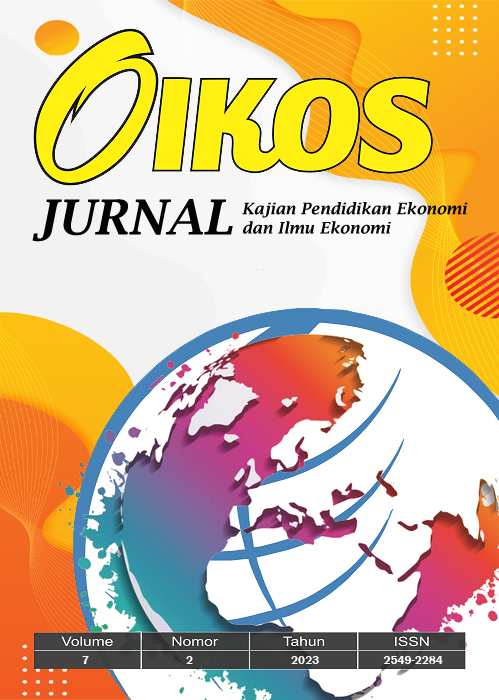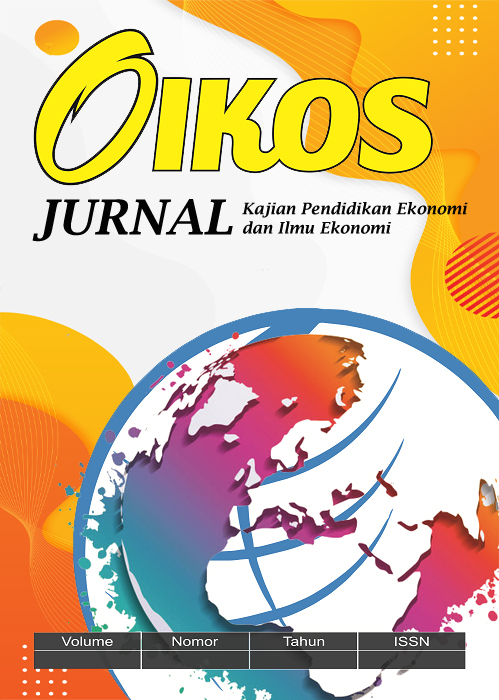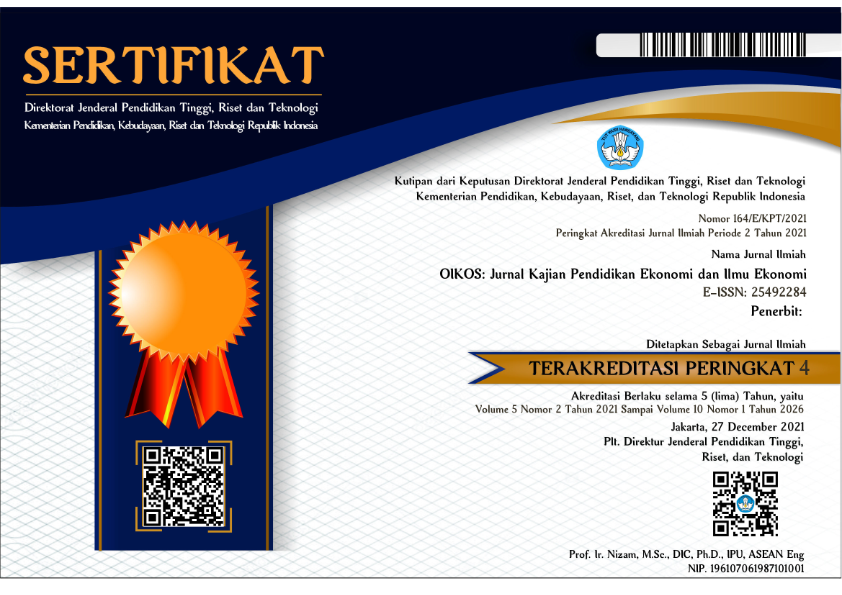PREDICTION OF FINANCIAL DISTRESS USING ARTIFICIAL NEURAL NETWORK (ANN) CASE STUDY IN BANKING COMPANIES LISTED ON THE INDONESIA STOCK EXCHANGE (IDX) PERIOD 2017-2021
DOI:
https://doi.org/10.23969/oikos.v7i2.7924Abstract
The Earnings Per Share (EPS) value from 2017 to 2021 shows how banking companies listed on the Indonesia Stock Exchange (IDX) did. Several banking companies experienced a decrease in EPS values from 2017 to 2021 and even obtained a negative EPS value which could indicate that the company identified as having a poor profit growth value and even triggering financial distress. This study plans to foresee the event of monetary trouble in financial organizations recorded on the Indonesia Stock Trade for the 2017-2021 period by utilizing a Fake Brain Organization. The info boundaries utilized are monetary proportions, specifically the ongoing proportion, return on resources, obligation to-resource proportion, and complete resource turnover. The results of the study show that the four ratios are suitable for use as input parameters because they provide significant differences between companies that declared distress and non-distress. This study's prediction process utilized an ANN architecture consisting of 20 neurons as the input layer, 5 neurons as the hidden layer, and 1 neuron as the output layer, achieving the highest accuracy of 87 percent.
Keywords: Artificial Neural Network, Financial Distress, Financial Ratios.
Downloads
References
Alamsyah, A., Kristanti, N., & Kristanti, F. T. (2021). Early warning model for financial distress using Artificial Neural Network. IOP Conference Series: Materials Science and Engineering, 1098(5), 052103. https://doi.org/10.1088/1757-899x/1098/5/052103
Chen, M. Y. (2011). Predicting corporate financial distress based on the integration of decision tree classification and logistic regression. Expert Systems with Applications, 38(9), 11261–11272. https://doi.org/10.1016/j.eswa.2011.02.173
Chen, W. Sen, & Du, Y. K. (2009). Using neural networks and data mining techniques for the financial distress prediction model. Expert Systems with Applications, 36, 4075–4086. https://doi.org/10.1016/j.eswa.2008.03.020
Cooper, D. R., & Schindler, P. S. (2014). Business Research Method (12th ed.). MCGraw-Hill/Lewin.
Dianova, A., & Nahumury, J. (2019). Investigating the Effect of Liquidity, Leverage, Sales Growth and Good Corporate Governance on Financial Distress. Journal of Accounting and Strategic Finance, 2(2), 143–156. https://doi.org/10.33005/jasf.v2i2.49
ElBannan, M. A. (2021). On the Prediction of Financial Distress in Emerging Markets: What Matters More? Empirical Evidence from Arab Spring Countries. Emerging Markets Review, 47, 1–6. https://doi.org/https://doi.org/10.1016/j.ememar.2021.100806
Enumah, S. J., & Chang, D. C. (2021). Predictors of Financial Distress Among Private U.S. Hospitals. Journal of Surgical Research, 267, 251–259. https://doi.org/https://doi.org/10.1016/j.jss.2021.05.025
Fahmi, I. (2011). Analisis Kinerja Keuangan (I). Alfabeta CV.
Fahmi, I. (2018). Pengantar Manajemen Keuangan (M. A. Djalil, Ed.). Alfabeta CV.
Fasya, N. S., & Rikumahu, B. (2021). Analisis Prediksi Financial Distress Menggunakan Artificial Neural Network Pada Perusahaan Perdagangan Eceran (Retail) Yang Terdaftar Pada Bursa Efek Indonesia. International Journal of Advanced Research in Economics and Finance, 4–7.
Fredrick, I., & Osazemen C., E. (2018). Capital structure and corporate financial distress of manufacturing firms in Nigeria. Journal of Accounting and Taxation, 10(7), 78–84. https://doi.org/10.5897/jat2018.0309
Hery. (2015). Analisis Kinerja Manajemen. PT Grasindo.
Hidayat, W. W. (2018). Dasar-Dasar Analisa Laporan Keuangan. Uwais Inspirasi Indonesia.
Keown, A. J., Martin, J. D., Pretty, J. W., & JR, D. F. S. (2008). Manajemen Keuangan: Prinsip dan Penerapan (10th ed.). PT Indeks.
Kristanti, F. T. (2019). Financial Distress - Teori dan Perkembangannya dalam Konteks Indonesia (I). Intelligentsia Media.
Kristianto, H., & Rikumahu, B. (2019). A Cross Model Telco Industry Financial Distress Prediction in Indonesia: Multiple Discriminant Analysis, Logit, and Artificial Neural Network. 7th International Conference on Information and Communication Technology, 1–5.
Muparuri, L., & Gumbo, V. (2022). On logit and artificial neural networks in corporate distress modeling for Zimbabwe listed corporates. Sustainability Analytics and Modeling, 2, 2–10. https://doi.org/https://doi.org/10.1016/j.samod.2022.100006
Nasir, M. L., John, R. I., Bennett, S. C., Russell, D. M., & Patel, A. (2000). Predicting corporate bankruptcy using artificial neural networks. Journal of Applied Accounting Research, 5(3), 30–52. https://doi.org/10.1108/96754260080001017
Nur, T., & Panggabean, R. R. (2020). Accuracy of Financial Distress Model Prediction: The Implementation of Artificial Neural Network, Logistic Regression, and Discriminant Analysis. Advances in Social Science, Education, and Humanities Research, 436, 402–406. https://ssrn.com/abstract=3597666
Ozkan-Gunay, E. N., & Ozkan, M. (2007). Prediction of bank failures in emerging financial markets: an ANN approach. Journal of Risk Finance, 8(5), 465–480. https://doi.org/10.1108/15265940710834753
Paule-Vianez, J., Gutiérrez-Fernández, M., & Coca-Pérez, J. L. (2020). Prediction of financial distress in the Spanish banking system: An application using artificial neural networks. Applied Economic Analysis, 28(82), 69–87. https://doi.org/10.1108/AEA-10-2019-0039
Pranita, K. R., & Kristanti, F. T. (2020). Analisis Financial Distress menggunakan Analisis Survival. Nominal: Barometer Riset Akuntansi Dan Manajemen, 9(2), 240–255. www.kemenperin.go.id
Prasetyo, E. (2012). Data Mining Konsep dan Aplikasi Menggunakan Matlab. Andi.
Salehi, M., Mousavi Shiri, M., & Bolandraftar Pasikhani, M. (2016). Predicting Corporate Financial Distress Using Data Mining Techniques: An Application in Tehran Stock Exchange. International Journal of Law and Management, 58(2), 216–230.
Sidhu, A. V., Jain, P., Singh, S. P., Kanoujiya, J., Rawal, A., Rastogi, S., & Bhimavarapu, V. M. (2023). Impact of Financial Distress on the Dividend Policy of Banks in India. Journal of Risk and Financial Management, 16(107), 2–13. https://doi.org/10.3390/jrfm16020107
Suwardi. (2015). Hukum Dagang Suatu Pengantar. Deepublish.
Wu, D., Ma, X., & Olson, D. L. (2022). Financial distress prediction using integrated Z-score and multilayer perceptron neural networks. Decision Support Systems, 159, 2–7. https://doi.org/10.1016/j.dss.2022.113814
Zhou, F., Fu, L., Li, Z., & Xu, J. (2022). The recurrence of financial distress: A survival analysis. International Journal of Forecasting, 38(3), 1100–1115. https://doi.org/10.1016/j.ijforecast.2021.12.005
Downloads
Published
Issue
Section
License
Copyright (c) 2023 Oikos : Jurnal Ekonomi dan Pendidikan Ekonomi

This work is licensed under a Creative Commons Attribution 4.0 International License.









